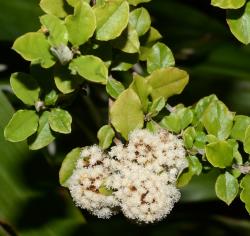- Taxon
- Gallery
- ≡ Ozothamnus lanceolatus Buchanan, Trans. New Zealand Inst. 2: 88 (1870)
- ≡ Helichrysum glomeratum var. lanceolatum (Buchanan) Allan, Fl. New Zealand 1, 718 (1961)
- = Swammerdamia glomerata Raoul, Ann. Sci. Nat., Bot. sér. 3, 2: 120 (1844)
- ≡ Ozothamnus glomeratus (Raoul) Hook.f., Bot. Antarct. Voy. II. (Fl. Nov.-Zel.) Part I, 133 (1852)
- ≡ Helichrysum glomeratum (Raoul) Benth. & Hook.f. ex Kirk, Gen. Pl. [Bentham & Hooker f.] 2(1), 311 (1873) nom. illeg., non Helichrysum glomeratum Klatt 1896
- ≡ Helichrysum aggregatum Yeo, Taxon 19: 946 (1970) nom. nov. pro Swammerdamia glomerata Raoul 1844
- = Helichrysum glomeratum var. majus Allan, Fl. New Zealand 1, 718, 972 (1961)
Much-branched shrub up to c. 3 m tall; branchlets not obscured by lvs, tomentose when very young, soon almost glabrous, c. 1–2 mm diam. Lvs spreading, distant, glabrous on upper surface, densely white-tomentose on lower, elliptic, ovate-elliptic, or broad-ovate to orbicular, obtuse to slightly retuse, mucronate, with narrow long-cuneate base < to c. = lamina, (6)–10–40–(50) × 4–25 mm. Lvs on flowering shoots smaller. Capitula 1–2 mm diam., 5-many in axillary or terminal, sessile or shortly pedunculate clusters, or clusters aggregated into small branched infls. Middle involucral bracts glabrous to moderately hairy, oblong- to ovate-elliptic, obtuse, not radiating, with transparent membranous lamina and opaque stereome, 2–3 mm long. Disc pale yellow. Achenes minutely papillate, cylindric, angled, c. 0.6 mm long.
[From: Webb et al. (1988) Flora of New Zealand. Volume 4.]




